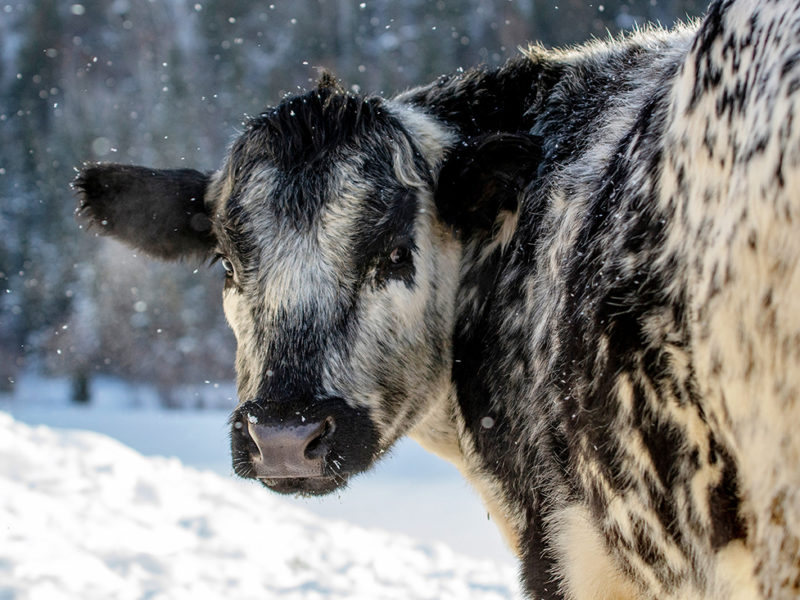MERRITT – How do you design a cow for the evolving Canadian climate?
That’s the question Thompson Rivers University associate professor John Church asked the BC Bison Association in late October, noting the estimated increase in global temperatures could see cattle regularly exposed to summer heat approaching 40°C.
Countering the effects of heat stress is a growing focus for North America’s cattle industry.
“We know that cattle will feed less and that will impact their average daily gain in high heat conditions, and it will also impact conception rates,” Church says. “What they are finding in Texas is that when cattle go through a big heat wave, it damages their gut linings permanently and they have to be on feed longer to get to finished size in the feedlot.”
Church says it takes a lot for cattle to die from heat, but 5,000 cattle perished from extreme heat in California in 2017. Research is on-going into heat-tolerant traits and breeds, as well as mitigation strategies such as shading and water cooling.
“But we still have the cold,” says Church, noting that winter temperatures can hit -40°C, the exact opposite of summer’s highs.
Cattle that perform well in hot climates, such as Brahmas, have light-coloured, thin coats that wouldn’t help them in the cold. Black Angus tolerate the cold, but their coat colour absorbs the heat in summer.
“We started to look at Canadian Speckle Park cattle,” says Church. “It’s a registered Canadian-developed breed that is known for producing well-marbled meat on a variety of forage. They are naturally polled, good calvers and are considered docile.”
But most important for Church, their coats range from black with light speckling, to nearly all white. Church wondered if the white coats would make them better-adapted to heat than Black Angus.
Church’s heat stress studies used a drone-mounted infrared thermal camera to fly over cattle and measure their surface temperature. The drone flew around the animals and sampled a variety of locations on the body.
The results, he says, were “shocking.”
On a 24°C day, Church says the Speckle Park were averaging 31.2°C while the Black Angus were 36.4°C.
“When we did all the stats, it was about a seven-degree Celsius difference between the two breeds of animals,” he says.
That’s due to the albedo effect, Church explains – the phenomenon on light-coloured surface reflecting more solar radiation than a dark surface.
In addition to studying Speckle Park, Church says he is working on his own breed, which he’s dubbed “Church’s Climate Master.” He is experimenting with Senepol, a very heat-tolerant breed from the Bahamas, and crossing them with Red Angus. He’s also looking at back-crossing Japanese Akaushi cattle with the Senepol.
But what does all this mean for bison producers?
Church notes that bison are naturally adapted to North America’s climate and its changes over the millennia.
“Bison have been in North America at least six million years and they have already survived a six-degree Celsius temperature warming according to archeological records,” he says.
Church wonders if the time is right to revive beefalo breeding, the bison-cattle crosses produced in the 1960s.
“I’ve read all the studies,” says Church. “The idea was you could take cattle and bison and cross them, and the hope was you would get something that was more adapted to the climate and a little easier to handle.”
It was a good idea that flopped, Church says.
“In fact, they got the worst of both,” he says. “They got cattle that were wild as shit to handle, just as bad as bison, and they weren’t very cold-tolerant.”
His recommendation is to boost bison numbers, and see them as a genuine alternative to cattle.
“We could just eat bison and give up cattle if it gets hot,” Church says. “I am convinced they can adapt better than our cows can.”
Some will argue that beef cattle have displaced bison from their rightful place in North America, but he notes that they’ve done more than that. While some estimates put the number of bison at 60-70 million “before we shot them all,” he says there are now about 120 million cows on the continent. It would be very hard to replace that large of a meat source with bison.
“And have you ever tried to milk one?” he asks with a chuckle. “I don’t think so, and that might be a problem.”


 Cherry growers see record crop losses in 2019
Cherry growers see record crop losses in 2019